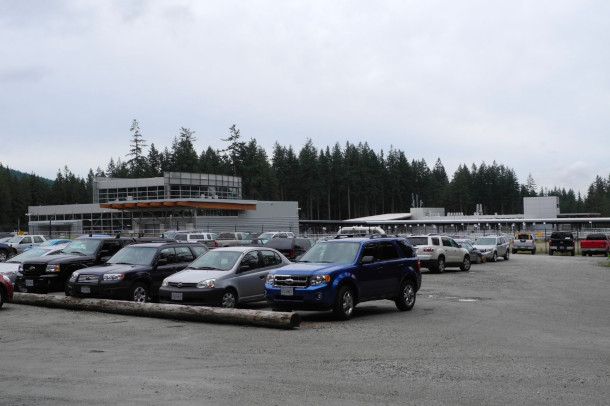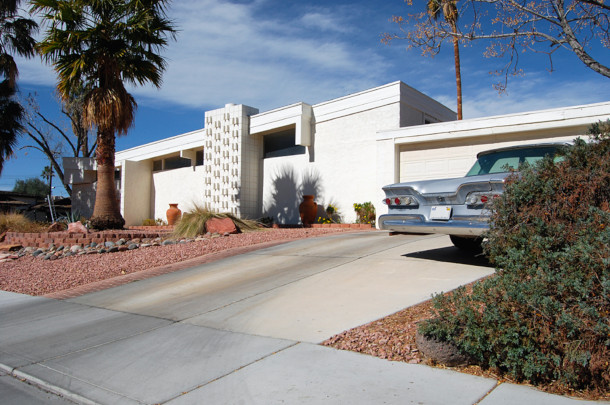Parking Reform and Climate Change
Air Date: Week of October 21, 2022

California Governor Gavin Newsom signed a bill last month prohibiting minimum parking requirements in hopes to reduce vehicle emissions and free more space for housing and businesses in urban areas. (Photo by flightlog, Flickr, CC BY 2.0)
Suburban sprawl adds to climate disruption by promoting driving and to accommodate commuters, some 30 percent of urban land is already devoted to parking. Even more spaces are often required when buildings are constructed or renovated. Now some cities and states, including California, are steering away from parking space mandates. Gernot Wagner, a climate economist at Columbia Business School, joins Host Steve Curwood to discuss what parking reform may look like for cities.
Transcript
CURWOOD: Suburban sprawl not only promotes social isolation and destroys wildlife habitat, it also adds to climate disruption as only one percent of cars these days are EVs and people in the ‘burbs do need cars to get around, as well as places to park them. To accommodate commuters coming in from the suburbs some 30 percent of urban land is devoted to parking, and more spaces are often required when buildings are constructed or renovated. In fact, so much land is taken up by parking that some economists say those mandates drive up the price of urban real estate, crowding out affordable housing and walkable retail. Now some states and cities are steering away from parking space mandates with measures like Assembly Bill 2097 in California. Gernot Wagner is a climate economist at Columbia Business School and he’s here to take a closer look at what parking reform could look like. Gernot, welcome back to Living on Earth!
WAGNER: Thanks, Steve.
CURWOOD: Professor, what exactly are parking mandates and how is it pushing people to live farther away from cities and into suburbs?
WAGNER: Parking mandates are sort of this, this funny thing that's been with us essentially forever, that is requiring homebuilders, homeowners, commercial builders to provide a certain number of parking spots. Because government subsidizes heavily suburbanization, driving, and the more parking spots we have in the city or at the fewer homes, the further people will live from wherever you want to go. And the cheaper in the all encompassing sense of the term, it suddenly is to drive.
CURWOOD: So just how much parking do we have in the United States and particularly in cities?
WAGNER: Well, too much is the short answer. Silicon Valley, for example, not even counting individual homes, there is two or three parking spots per car, just waiting around, sitting around. If you add it up nationwide, we have 2 billion parking spots for something like 280 million cars.
CURWOOD: You have looked at Los Angeles, and the parking situation there and have some numbers in an article you recently wrote. Talk to me about those numbers you see around LA and parking.
WAGNER: Every thousand square foot restaurant or bar in LA must provide at least 10 parking spots, which ends up with the restaurant being about half the size of the parking lot. Right, the bar owner, the restaurant owner, would love to have more space for customers, just sits there unused. None of this is natural or is driven by market forces, but is required to overbuild.
CURWOOD: Now, from what I hear there's this bill in California to eliminate parking minimums. Talk to me about it. I think it's called AB 2097, Assembly Bill 2097. What exactly does it entail for housing and parking space?

As parking minimums take away spaces to develop low-cost housing in cities, developers continue to create housing further away from cities and into the suburbs. (Photo: Roadsidepictures, Flickr, CC BY-NC 2.0)
WAGNER: So I am very happy to say that Governor Newsom, in fact has signed this bill into law already. So Assembly Bill 2097, eliminates parking mandates across the state. It requires a rethinking of the way we, or Californians in this case, have thought about development for a long time. What we have seen over the past years, decades of essentially saying, "No no no, I like my single family home here. We, you know, yes, we need more housing, but build it over there, not here." And these parking minimums have contributed to just this sort of development, driving up home prices in cities and leading to ever more development in, you know, further out in the suburbs, leading to greater vulnerability to wildfires, and lots of other unsavory consequences.
CURWOOD: Yeah, how is parking related to poverty and homelessness?
WAGNER: So us under building, massively under building homes in cities, while reserving spaces for cars, and all of that, in many ways, up to a point isn't government creation. It's a creation of the minimum parking requirements, which leads to fewer homes, fewer apartments, fewer houses being built, and the trade off is pushing people further out into suburbs.
CURWOOD: What connections can you show between getting rid of parking minimums and reducing carbon emissions?
WAGNER: The most direct connection is that cities cut carbon. The average urbanite emits somewhere around half, perhaps even only a third of the CO2 of the average person, the average household in the suburbs. And it's actually pretty striking to look at the overall picture. So, you know, living on the land off the land, in a truly rural environment is fantastic. But what's the compromise? Compromise is nature, the climate and frankly, time stuck in traffic. But back to the big picture, yes, cities do cut carbon.
CURWOOD: So somebody's listening to us though, Gernot, would say if you get rid of parking spaces, how are you going to get around?

Gernot Wagner is a professor and climate economist at the Columbia Business School. (Photo: Courtesy of Gernot Wagner)
WAGNER: Urbanites, like myself, right, who don't need or want cars have it relatively easy. You have basically everything within walking, biking distance, including your office, including the playground. And of course, it's it's a different vision for how to organize society for awesome suburbia, whereas some others simply depend on the car. And to be clear, the right number is not one parking spot nationwide per car. We need more parking spots because otherwise you don't get around, right? It's not like you take your car and just, you know, go in circles and come back to where you started. No. On the other hand, it is also pretty clear that 2 billion parking spots for 280 million cars is a massive overbuilding.
CURWOOD: Talk to me about some examples in other cities or countries where there is parking reform and there are no parking minimums.
WAGNER: Amazingly, there are in fact, in this country in the US, there are some cities and frankly, lots you wouldn't necessarily expect to, who just recently got rid of their own minimum parking requirements. Santa Monica, California is an example, Raleigh in North Carolina, Hartford, Connecticut, Buffalo, Upstate New York. All of them got rid of their minimum parking requirements. Now, they've all done so recently, right, so it's not like there's been already a revolution on the way. Those who used to live in single family homes outside the city still for the most part do. But more homes are being built fewer parking spots, fewer on street parking, they are some cities who actually went a step further. So San Francisco actually sticks out, Branson, Missouri. They went as far as to adopt parking maximums, limiting how much parking could be provided.
CURWOOD: Gernot Wagner is a climate economist at the Columbia Business School. Thanks so much for taking the time with us today.
WAGNER: Thanks, Steve.
Links
Bloomberg | “The Next Step on Climate Action: Parking Reform”
Living on Earth wants to hear from you!
Living on Earth
62 Calef Highway, Suite 212
Lee, NH 03861
Telephone: 617-287-4121
E-mail: comments@loe.org
Newsletter [Click here]
Donate to Living on Earth!
Living on Earth is an independent media program and relies entirely on contributions from listeners and institutions supporting public service. Please donate now to preserve an independent environmental voice.
NewsletterLiving on Earth offers a weekly delivery of the show's rundown to your mailbox. Sign up for our newsletter today!
 Sailors For The Sea: Be the change you want to sea.
Sailors For The Sea: Be the change you want to sea.
 The Grantham Foundation for the Protection of the Environment: Committed to protecting and improving the health of the global environment.
The Grantham Foundation for the Protection of the Environment: Committed to protecting and improving the health of the global environment.
 Contribute to Living on Earth and receive, as our gift to you, an archival print of one of Mark Seth Lender's extraordinary wildlife photographs. Follow the link to see Mark's current collection of photographs.
Contribute to Living on Earth and receive, as our gift to you, an archival print of one of Mark Seth Lender's extraordinary wildlife photographs. Follow the link to see Mark's current collection of photographs.
 Buy a signed copy of Mark Seth Lender's book Smeagull the Seagull & support Living on Earth
Buy a signed copy of Mark Seth Lender's book Smeagull the Seagull & support Living on Earth

